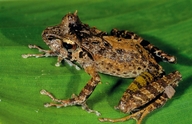|
Description
M 27-40 mm, F 37 mm. Specimens from northern Madagascar are clearly larger than those from Andasibe in the central east. A relatively slender frog. Back granular, dorsolateral folds not or weakly expressed. Very typical is a distinct and elevated transversal connecting dorsal ridge on the back. Two interocular tubercles, small rudiments of a heel spine, and distinct supraocular spines are present (Glaw and Vences 2007). Distribution and Habitat
Country distribution from AmphibiaWeb's database: Madagascar
Ambanizana, Ambolokopatrika, Andasibe, Mananara, Marojejy (Glaw and Vences 2007). This species occurs at 300-900 m asl, in pristine rainforest (Vences et. al 2008).Life History, Abundance, Activity, and Special Behaviors
Habits: Males call at night along small streams in rainforest, perched 0.5-1.5 m above the ground in the vegetation (Glaw and Vences 2007). It is not clear whether this species breeds by direct or larval development. Sometimes found at a distance from streams (Vences et al. 2008).
Calls: A slow series of short unharmonious notes (Glaw and Vences 2007).
Trends and Threats
This species is listed as least concern in view of its relatively wide distribution, presumed large population, and because it is unlikely to be declining fast enough to qualify for listing in a more threatened category. Occurs in several protected areas. Outside of those areas, it is threatened by habitat loss due to increasing subsistence agriculture, logging, charcoal manufacture, invasion and spread of eucalyptus, increased livestock grazing and expanding human settlement (Vences et al. 2008). Possible reasons for amphibian decline General habitat alteration and loss
Habitat modification from deforestation, or logging related activities
Intensified agriculture or grazing
Urbanization
Subtle changes to necessary specialized habitat
Comments
Taken with permission from Glaw and Vences (2007).
References
Glaw, F., and Vences, M. (2007). Field Guide to the Amphibians and Reptiles of Madagascar. Third Edition. Vences and Glaw Verlag, Köln.
Vences, M., Glaw, F. and Andreone, F. (2008). Gephyromantis moseri. In: IUCN 2008. 2008 IUCN Red List of Threatened Species. www.iucnredlist.org. Downloaded on 20 March 2009.
Originally submitted by: Miguel Vences and Frank Glaw (first posted 2009-03-20)
Edited by: Catherine Aguilar (2009-04-07)Species Account Citation: AmphibiaWeb 2009 Gephyromantis moseri <https://amphibiaweb.org/species/6032> University of California, Berkeley, CA, USA. Accessed Jun 14, 2025.
Feedback or comments about this page.
Citation: AmphibiaWeb. 2025. <https://amphibiaweb.org> University of California, Berkeley, CA, USA. Accessed 14 Jun 2025.
AmphibiaWeb's policy on data use.
|
